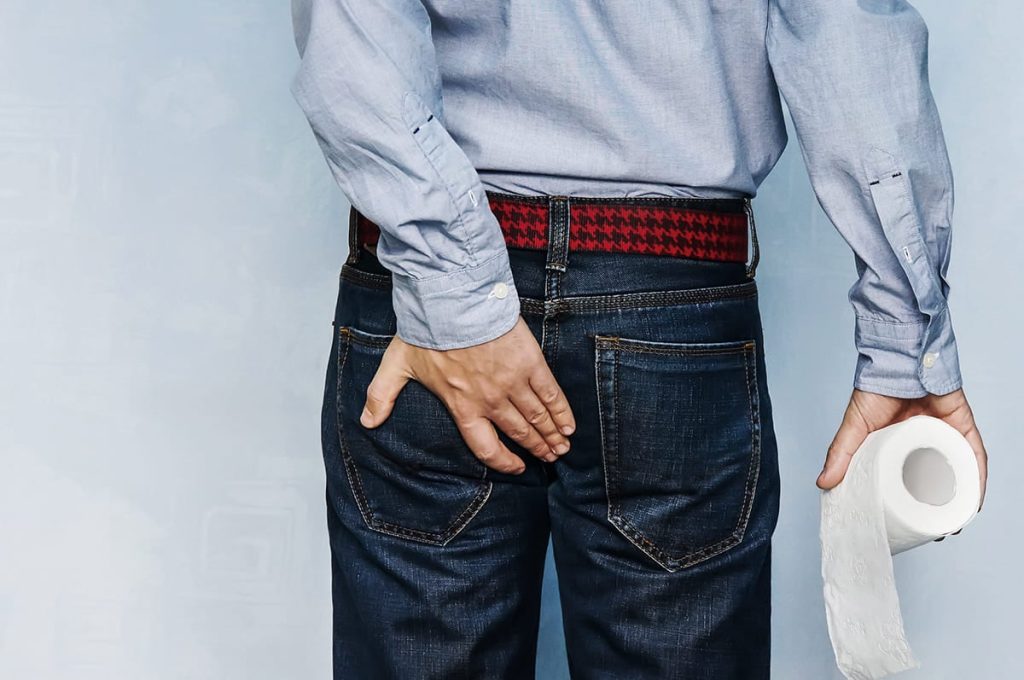Hemorrhoids are a common disease caused by the bulging of small blood vessels in the rectal mucosa, as well as the laxity of the connective tissue of the rectal mucosa.

Many factors cause hemorrhoids to form.
Such as abnormal bowel habits (constipation or diarrhea), deterioration of blood vessels and muscles in the elderly, eating foods low in fiber, increased intra-abdominal pressure for a long time, such as lifting heavy objects regularly, pregnancy, etc.
Symptoms of hemorrhoids
There will be bright red blood in the stool, often found after defecation or bright red blood found on toilet paper while wiping the buttocks. There will be a lump protruding while straining to defecate. In some cases, there may be symptoms of dizziness, vertigo, and easy fatigue due to anemia from chronic blood loss. In general, hemorrhoids do not have pain, except when there are complications, such as acute blood clots in hemorrhoids or hemorrhoid ischemia because hemorrhoids are too large to push back into the anus.
How to treat hemorrhoids
Focus on disease prevention by choosing to eat foods that are high in fiber, drinking enough water, about 8-10 glasses/day, exercising regularly, avoiding straining to pass stool for a long time. When having abnormal bowel movements or bloody stools, แทงบอล UFABET ราคาดีที่สุด ไม่มีขั้นต่ำ see a doctor to find the cause of the disease. And if the symptoms are caused by hemorrhoids, if you see a doctor quickly, you may be able to receive treatment with other methods without having to undergo surgery.
Treatment selection
Which method is used depends on the stage and severity of the disease. In cases where symptoms are not severe, the doctor may consider treating the patient with medication to reduce symptoms in the acute phase, along with advice on disease prevention. In cases where there is severe blood loss, treatment may be performed by ligating with a rubber band to stop the bleeding (Rubber band ligation). However, in cases where the hemorrhoids are large or have sagging significantly, surgery may be necessary.
In the past, patients who had to undergo hemorrhoid surgery had to stay in the hospital for about 3-4 days and had an external surgical wound on the anus. The surgical wound was painful. They had to sit in warm water to clean the wound and reduce the pain. The wound was painful when defecating. The surgical wound was constantly seeping water during the initial period after surgery. They had to use gauze, sanitary pads, or diapers to absorb the water.
It took about 2-4 weeks for the wound to heal completely. This made most patients afraid of surgery.
Nowadays, there are more options for surgical treatment because of the development of hemorrhoid surgery techniques, which make patients experience less pain from the surgical wound or no pain at all. The surgery uses a circular hemorrhoid suturing instrument (Stapled Haemorrhoidopexy) to cut the hemorrhoids around and fasten the tissue around the anus back into the anus.
The surgical wound is hidden in the anus, resulting in no external wound, reducing the problem of pain after surgery. There is less chance of blood loss during surgery, less pain during defecation, and a shorter recovery time because the wound is not painful and heals faster than traditional surgical methods. In addition, there are effective painkillers today, resulting in patients being happier and more comfortable after surgery than in the past.